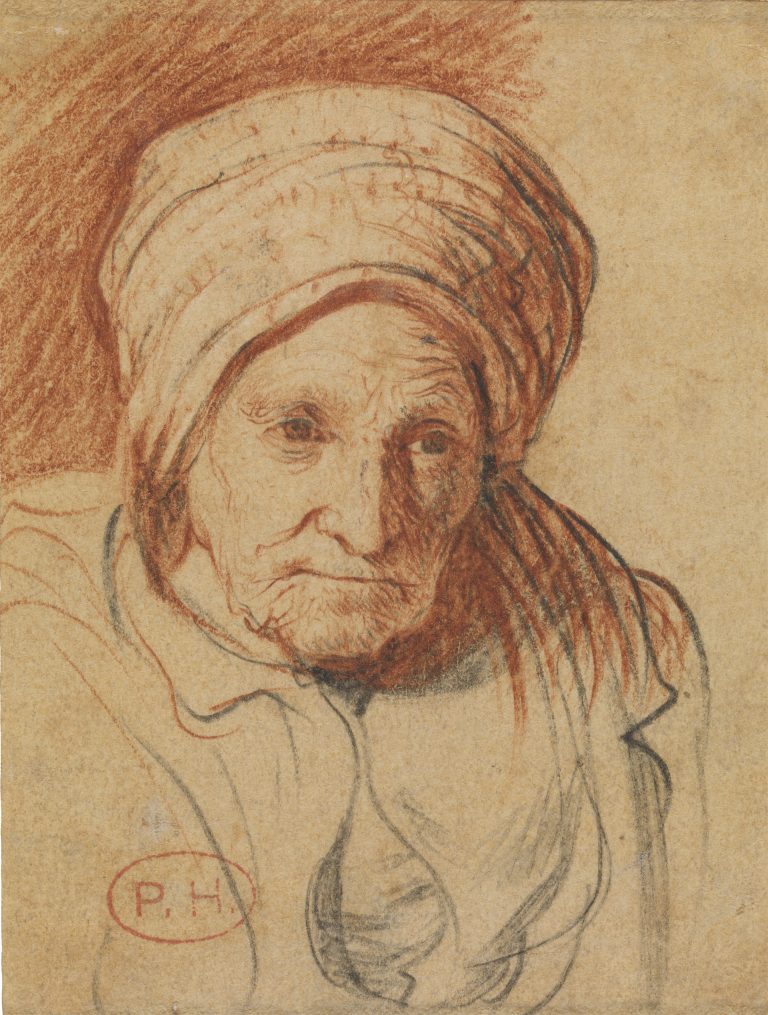With an intense gaze animating her stern visage, this elderly woman with pointed nose, square jaw, and pursed lips seems formidable even given the small scale of the sheet of paper on which she is drawn. Jan Lievens has rendered the ample headdress covering her hair and the heavy apparel over her shoulders that shield her body from the viewer’s eyes with quick and supple lines of red and black chalk, but he has taken an entirely different approach for the expressive face that leans forward toward the viewer. Thin, delicately rendered lines define the woman’s features and the wrinkles of age that cross her forehead, circle her eyes, and draw the mouth down to its create its serious and uncompromising expression.
The attribution of this compelling drawing has been the subject of debate for many years. It was formerly attributed to Nicolaes Maes (1634–93), a pupil of Rembrandt van Rijn (1606–69) in the late 1640s and early 1650s. In 1980, however, Sumowski ascribed it, with reservation, to Gerrit Dou (1613–75), during the period that Dou was studying with Rembrandt in Leiden (1625–31). Sumowski’s association of the drawing with works created in Leiden during those years is correct, but the style of the drawing is consistent with Jan Lievens, not Dou. Reinforcing an attribution to Lievens is the direct correspondence that exists between this figure and the model for the prophetess Anna in his painting Old Woman Reading, ca. 1625 (fig 1).1 Anna wears a similar headdress, which falls loosely over her shoulders, and has similar facial features: a slightly pointed nose, a wrinkled face and forehead, and thin lips that hang down at the corners.2 The model, evidently a woman from the artists’ circle, has often been identified as Rembrandt’s mother, but this identification is uncertain.3
When Rembrandt and Lievens were working in Leiden, they both made drawings in red and black chalk, sometimes on yellowish, light-brown, prepared paper. This technique, which they adopted from their teacher, Pieter Lastman (1583–1633), can be seen in Lastman’s drawings from the early 1620s, which include several preparatory studies for paintings.4 Head of an Old Woman is also executed on this paper, as is another drawing by Lievens, Bust of an Old Man (fig 2), which has a drapery study on its verso.5
An excellent example of Rembrandt’s manner of drawing during the late 1620s that offers a point of comparison with Lievens’s drawing technique is his Seated Old Man with a Book, which he drew in red and black chalk, heightened with white, on yellowish, light-brown, prepared paper (fig 3).6 The drawing served as a preparatory study for the figure of Peter in the master’s Peter and Paul Disputing, a painting in Melbourne dated ca. 1628.7 Despite the importance of line in this drawing, it is executed more tonally than is Lievens’s drawing. Lievens’s line plays a more independent role, is more descriptive in character, and is rather decorative, particularly in the rendering of clothing. It is not as essential to the design, nor does it create the consistent lighting effects or plasticity seen in Rembrandt’s drawing style.
Lievens’s linear style is also encountered in other drawings (and prints) from his Leiden period, such as Old Woman in Half-Length Profile, Facing Left in Boston.8 As in Head of an Old Woman, in the Boston drawing Lievens has used a network of fine lines to depict the facial features (as he did in Bust of an Old Man), and in both works he has accentuated the contour of the woman’s headdress above her forehead. The linear, descriptive character of the features can also be seen in one of Lievens’s most Rembrandtesque drawings, Bearded Old Man in Profile in Washington.9
The place of Head of an Old Woman in Lievens’s oeuvre can be hypothesized by comparing it with Rembrandt’s comparable studies. Rembrandt’s portrait drawing of an old woman in Ulm, executed in pen and brush,10 may have originated in the same period as the two etched portraits he made of his “mother” of 1628.11 It seems likely that Lievens’s drawing should be dated to approximately the same time, around 1628, the year in which Rembrandt also executed his Seated Old Man with a Book.
